Report on Evidence-Based Practice: Aboriginal Children Influenza Study
VerifiedAdded on 2023/01/18
|12
|3421
|31
Report
AI Summary
This report critically analyzes a research study investigating the effectiveness of different communication methods (booklets and letters) in increasing influenza vaccination rates among Aboriginal children. The study employed a multi-arm parallel randomized control trial, comparing intervention groups receiving information about the vaccine to a control group receiving no direct communication. The report assesses the study's research question, relevance to nursing practice, potential risks, study design, methodology, intervention descriptions, and outcomes. It examines the impact of the interventions on vaccination rates, highlighting the effectiveness of letters compared to booklets. Furthermore, the report evaluates the study's level of evidence, its implications for evidence-based practice, and includes a reflection on the student's prior knowledge and concerns regarding immunization safety. The analysis considers potential biases and limitations, emphasizing the importance of clear communication and cultural sensitivity in public health interventions.
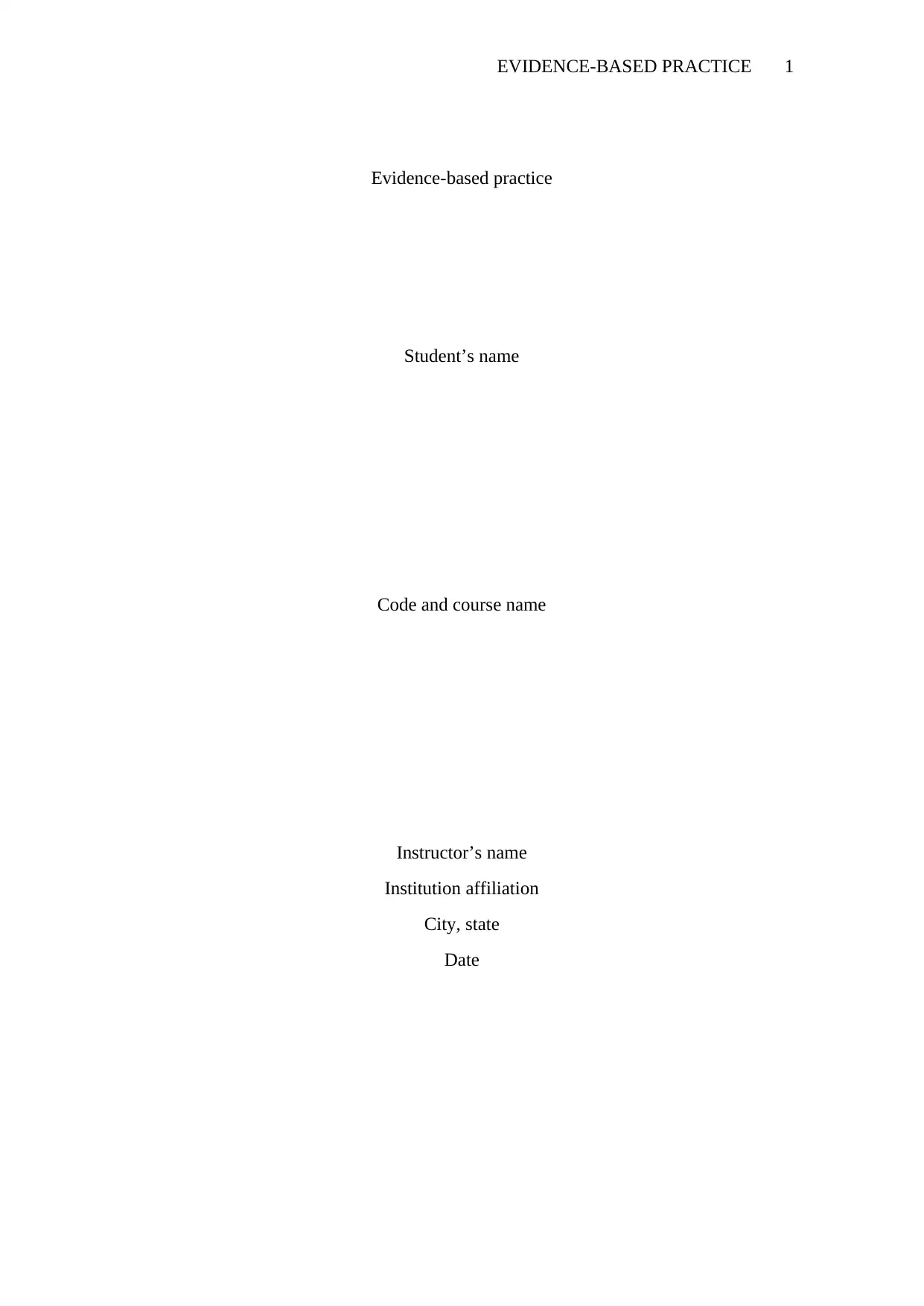
EVIDENCE-BASED PRACTICE 1
Evidence-based practice
Student’s name
Code and course name
Instructor’s name
Institution affiliation
City, state
Date
Evidence-based practice
Student’s name
Code and course name
Instructor’s name
Institution affiliation
City, state
Date
Paraphrase This Document
Need a fresh take? Get an instant paraphrase of this document with our AI Paraphraser
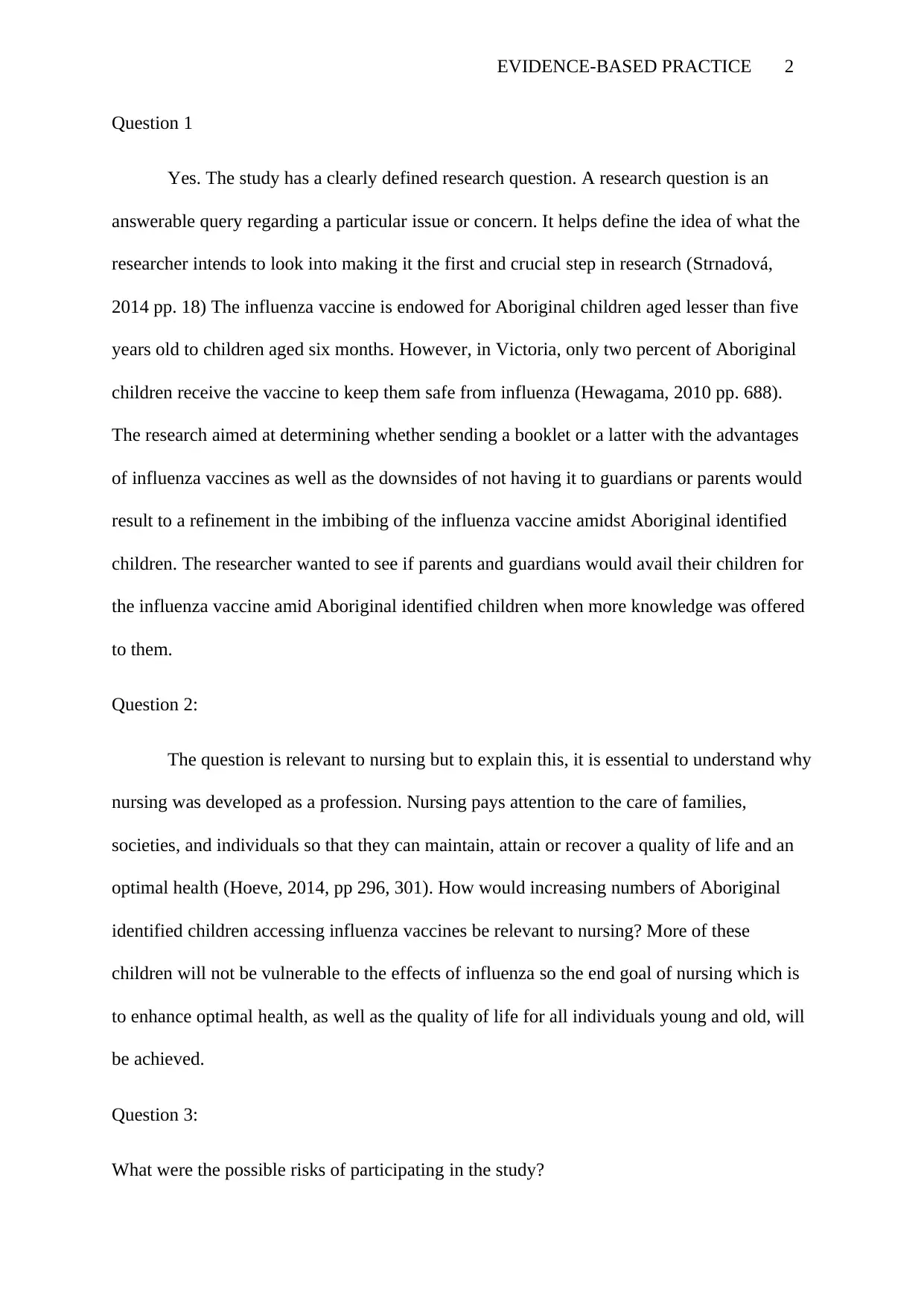
EVIDENCE-BASED PRACTICE 2
Question 1
Yes. The study has a clearly defined research question. A research question is an
answerable query regarding a particular issue or concern. It helps define the idea of what the
researcher intends to look into making it the first and crucial step in research (Strnadová,
2014 pp. 18) The influenza vaccine is endowed for Aboriginal children aged lesser than five
years old to children aged six months. However, in Victoria, only two percent of Aboriginal
children receive the vaccine to keep them safe from influenza (Hewagama, 2010 pp. 688).
The research aimed at determining whether sending a booklet or a latter with the advantages
of influenza vaccines as well as the downsides of not having it to guardians or parents would
result to a refinement in the imbibing of the influenza vaccine amidst Aboriginal identified
children. The researcher wanted to see if parents and guardians would avail their children for
the influenza vaccine amid Aboriginal identified children when more knowledge was offered
to them.
Question 2:
The question is relevant to nursing but to explain this, it is essential to understand why
nursing was developed as a profession. Nursing pays attention to the care of families,
societies, and individuals so that they can maintain, attain or recover a quality of life and an
optimal health (Hoeve, 2014, pp 296, 301). How would increasing numbers of Aboriginal
identified children accessing influenza vaccines be relevant to nursing? More of these
children will not be vulnerable to the effects of influenza so the end goal of nursing which is
to enhance optimal health, as well as the quality of life for all individuals young and old, will
be achieved.
Question 3:
What were the possible risks of participating in the study?
Question 1
Yes. The study has a clearly defined research question. A research question is an
answerable query regarding a particular issue or concern. It helps define the idea of what the
researcher intends to look into making it the first and crucial step in research (Strnadová,
2014 pp. 18) The influenza vaccine is endowed for Aboriginal children aged lesser than five
years old to children aged six months. However, in Victoria, only two percent of Aboriginal
children receive the vaccine to keep them safe from influenza (Hewagama, 2010 pp. 688).
The research aimed at determining whether sending a booklet or a latter with the advantages
of influenza vaccines as well as the downsides of not having it to guardians or parents would
result to a refinement in the imbibing of the influenza vaccine amidst Aboriginal identified
children. The researcher wanted to see if parents and guardians would avail their children for
the influenza vaccine amid Aboriginal identified children when more knowledge was offered
to them.
Question 2:
The question is relevant to nursing but to explain this, it is essential to understand why
nursing was developed as a profession. Nursing pays attention to the care of families,
societies, and individuals so that they can maintain, attain or recover a quality of life and an
optimal health (Hoeve, 2014, pp 296, 301). How would increasing numbers of Aboriginal
identified children accessing influenza vaccines be relevant to nursing? More of these
children will not be vulnerable to the effects of influenza so the end goal of nursing which is
to enhance optimal health, as well as the quality of life for all individuals young and old, will
be achieved.
Question 3:
What were the possible risks of participating in the study?
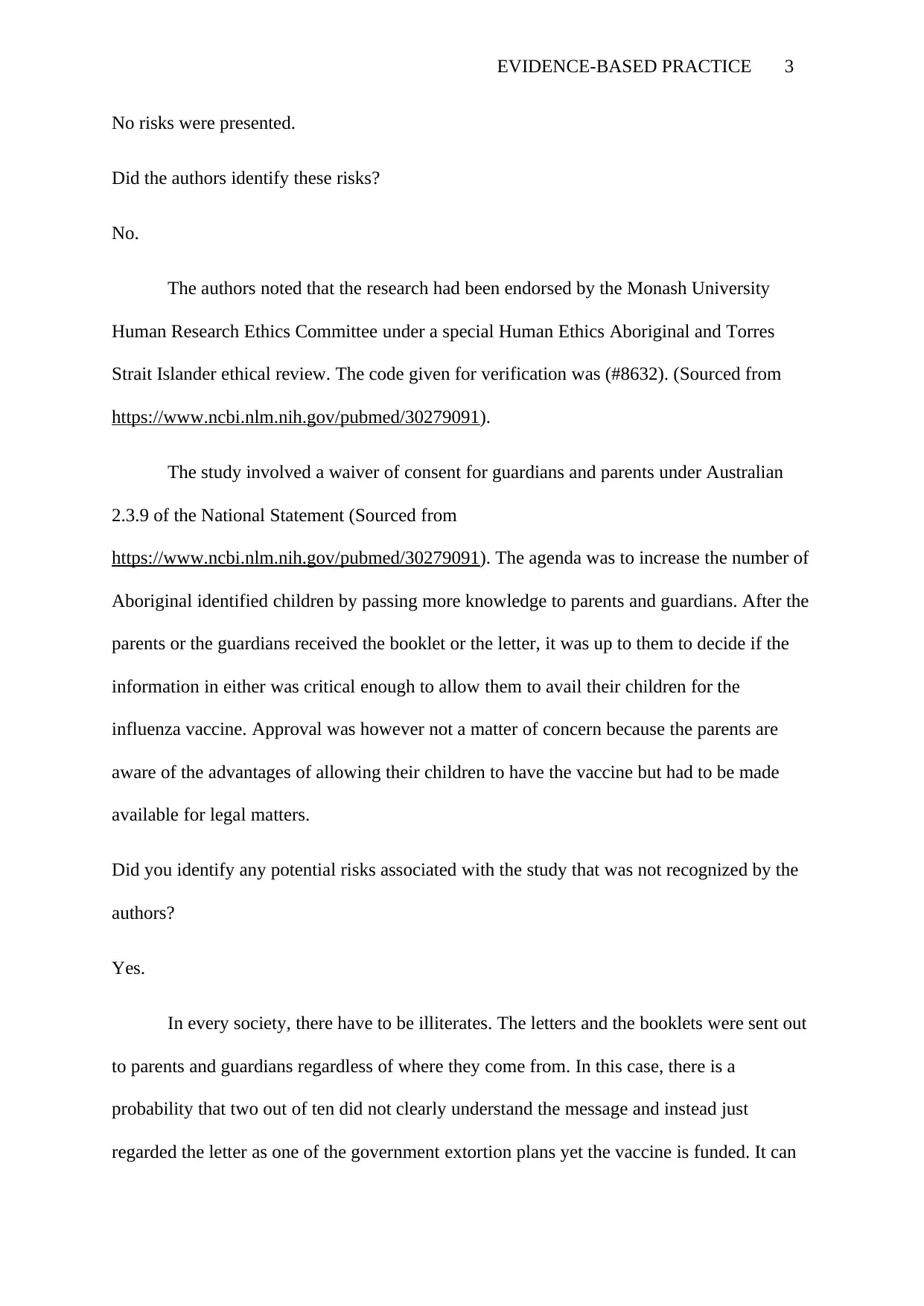
EVIDENCE-BASED PRACTICE 3
No risks were presented.
Did the authors identify these risks?
No.
The authors noted that the research had been endorsed by the Monash University
Human Research Ethics Committee under a special Human Ethics Aboriginal and Torres
Strait Islander ethical review. The code given for verification was (#8632). (Sourced from
https://www.ncbi.nlm.nih.gov/pubmed/30279091).
The study involved a waiver of consent for guardians and parents under Australian
2.3.9 of the National Statement (Sourced from
https://www.ncbi.nlm.nih.gov/pubmed/30279091). The agenda was to increase the number of
Aboriginal identified children by passing more knowledge to parents and guardians. After the
parents or the guardians received the booklet or the letter, it was up to them to decide if the
information in either was critical enough to allow them to avail their children for the
influenza vaccine. Approval was however not a matter of concern because the parents are
aware of the advantages of allowing their children to have the vaccine but had to be made
available for legal matters.
Did you identify any potential risks associated with the study that was not recognized by the
authors?
Yes.
In every society, there have to be illiterates. The letters and the booklets were sent out
to parents and guardians regardless of where they come from. In this case, there is a
probability that two out of ten did not clearly understand the message and instead just
regarded the letter as one of the government extortion plans yet the vaccine is funded. It can
No risks were presented.
Did the authors identify these risks?
No.
The authors noted that the research had been endorsed by the Monash University
Human Research Ethics Committee under a special Human Ethics Aboriginal and Torres
Strait Islander ethical review. The code given for verification was (#8632). (Sourced from
https://www.ncbi.nlm.nih.gov/pubmed/30279091).
The study involved a waiver of consent for guardians and parents under Australian
2.3.9 of the National Statement (Sourced from
https://www.ncbi.nlm.nih.gov/pubmed/30279091). The agenda was to increase the number of
Aboriginal identified children by passing more knowledge to parents and guardians. After the
parents or the guardians received the booklet or the letter, it was up to them to decide if the
information in either was critical enough to allow them to avail their children for the
influenza vaccine. Approval was however not a matter of concern because the parents are
aware of the advantages of allowing their children to have the vaccine but had to be made
available for legal matters.
Did you identify any potential risks associated with the study that was not recognized by the
authors?
Yes.
In every society, there have to be illiterates. The letters and the booklets were sent out
to parents and guardians regardless of where they come from. In this case, there is a
probability that two out of ten did not clearly understand the message and instead just
regarded the letter as one of the government extortion plans yet the vaccine is funded. It can
⊘ This is a preview!⊘
Do you want full access?
Subscribe today to unlock all pages.

Trusted by 1+ million students worldwide
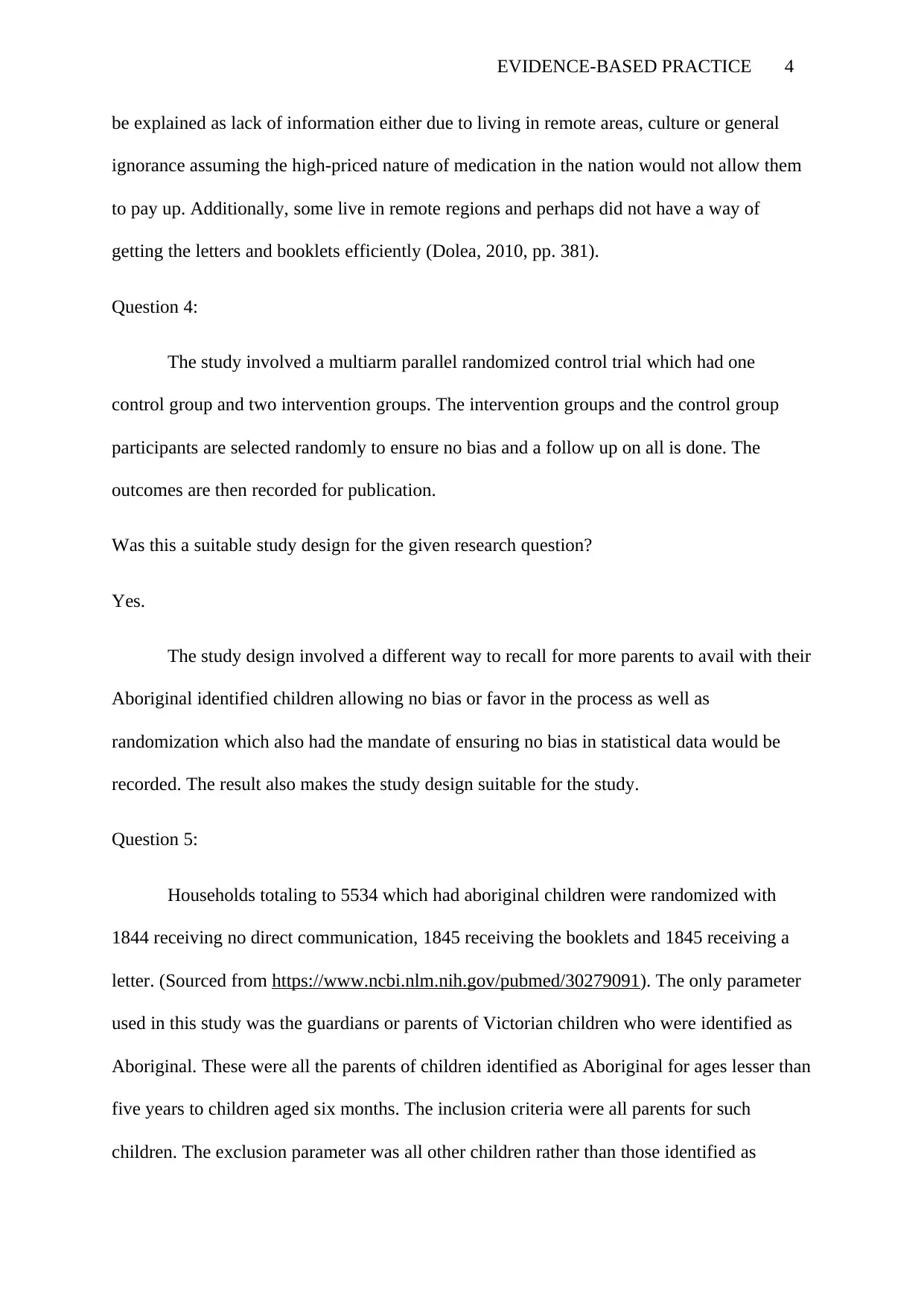
EVIDENCE-BASED PRACTICE 4
be explained as lack of information either due to living in remote areas, culture or general
ignorance assuming the high-priced nature of medication in the nation would not allow them
to pay up. Additionally, some live in remote regions and perhaps did not have a way of
getting the letters and booklets efficiently (Dolea, 2010, pp. 381).
Question 4:
The study involved a multiarm parallel randomized control trial which had one
control group and two intervention groups. The intervention groups and the control group
participants are selected randomly to ensure no bias and a follow up on all is done. The
outcomes are then recorded for publication.
Was this a suitable study design for the given research question?
Yes.
The study design involved a different way to recall for more parents to avail with their
Aboriginal identified children allowing no bias or favor in the process as well as
randomization which also had the mandate of ensuring no bias in statistical data would be
recorded. The result also makes the study design suitable for the study.
Question 5:
Households totaling to 5534 which had aboriginal children were randomized with
1844 receiving no direct communication, 1845 receiving the booklets and 1845 receiving a
letter. (Sourced from https://www.ncbi.nlm.nih.gov/pubmed/30279091). The only parameter
used in this study was the guardians or parents of Victorian children who were identified as
Aboriginal. These were all the parents of children identified as Aboriginal for ages lesser than
five years to children aged six months. The inclusion criteria were all parents for such
children. The exclusion parameter was all other children rather than those identified as
be explained as lack of information either due to living in remote areas, culture or general
ignorance assuming the high-priced nature of medication in the nation would not allow them
to pay up. Additionally, some live in remote regions and perhaps did not have a way of
getting the letters and booklets efficiently (Dolea, 2010, pp. 381).
Question 4:
The study involved a multiarm parallel randomized control trial which had one
control group and two intervention groups. The intervention groups and the control group
participants are selected randomly to ensure no bias and a follow up on all is done. The
outcomes are then recorded for publication.
Was this a suitable study design for the given research question?
Yes.
The study design involved a different way to recall for more parents to avail with their
Aboriginal identified children allowing no bias or favor in the process as well as
randomization which also had the mandate of ensuring no bias in statistical data would be
recorded. The result also makes the study design suitable for the study.
Question 5:
Households totaling to 5534 which had aboriginal children were randomized with
1844 receiving no direct communication, 1845 receiving the booklets and 1845 receiving a
letter. (Sourced from https://www.ncbi.nlm.nih.gov/pubmed/30279091). The only parameter
used in this study was the guardians or parents of Victorian children who were identified as
Aboriginal. These were all the parents of children identified as Aboriginal for ages lesser than
five years to children aged six months. The inclusion criteria were all parents for such
children. The exclusion parameter was all other children rather than those identified as
Paraphrase This Document
Need a fresh take? Get an instant paraphrase of this document with our AI Paraphraser
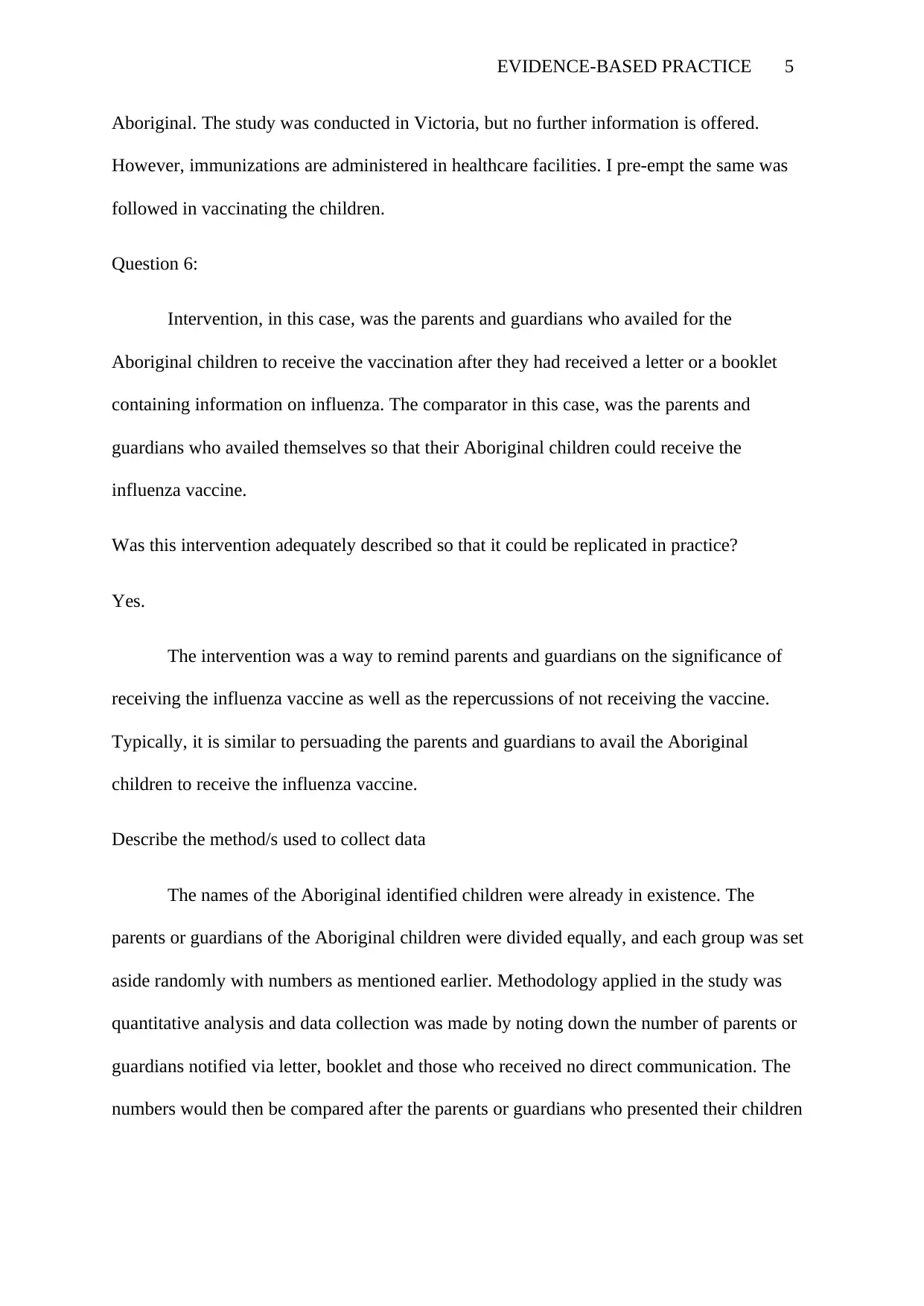
EVIDENCE-BASED PRACTICE 5
Aboriginal. The study was conducted in Victoria, but no further information is offered.
However, immunizations are administered in healthcare facilities. I pre-empt the same was
followed in vaccinating the children.
Question 6:
Intervention, in this case, was the parents and guardians who availed for the
Aboriginal children to receive the vaccination after they had received a letter or a booklet
containing information on influenza. The comparator in this case, was the parents and
guardians who availed themselves so that their Aboriginal children could receive the
influenza vaccine.
Was this intervention adequately described so that it could be replicated in practice?
Yes.
The intervention was a way to remind parents and guardians on the significance of
receiving the influenza vaccine as well as the repercussions of not receiving the vaccine.
Typically, it is similar to persuading the parents and guardians to avail the Aboriginal
children to receive the influenza vaccine.
Describe the method/s used to collect data
The names of the Aboriginal identified children were already in existence. The
parents or guardians of the Aboriginal children were divided equally, and each group was set
aside randomly with numbers as mentioned earlier. Methodology applied in the study was
quantitative analysis and data collection was made by noting down the number of parents or
guardians notified via letter, booklet and those who received no direct communication. The
numbers would then be compared after the parents or guardians who presented their children
Aboriginal. The study was conducted in Victoria, but no further information is offered.
However, immunizations are administered in healthcare facilities. I pre-empt the same was
followed in vaccinating the children.
Question 6:
Intervention, in this case, was the parents and guardians who availed for the
Aboriginal children to receive the vaccination after they had received a letter or a booklet
containing information on influenza. The comparator in this case, was the parents and
guardians who availed themselves so that their Aboriginal children could receive the
influenza vaccine.
Was this intervention adequately described so that it could be replicated in practice?
Yes.
The intervention was a way to remind parents and guardians on the significance of
receiving the influenza vaccine as well as the repercussions of not receiving the vaccine.
Typically, it is similar to persuading the parents and guardians to avail the Aboriginal
children to receive the influenza vaccine.
Describe the method/s used to collect data
The names of the Aboriginal identified children were already in existence. The
parents or guardians of the Aboriginal children were divided equally, and each group was set
aside randomly with numbers as mentioned earlier. Methodology applied in the study was
quantitative analysis and data collection was made by noting down the number of parents or
guardians notified via letter, booklet and those who received no direct communication. The
numbers would then be compared after the parents or guardians who presented their children
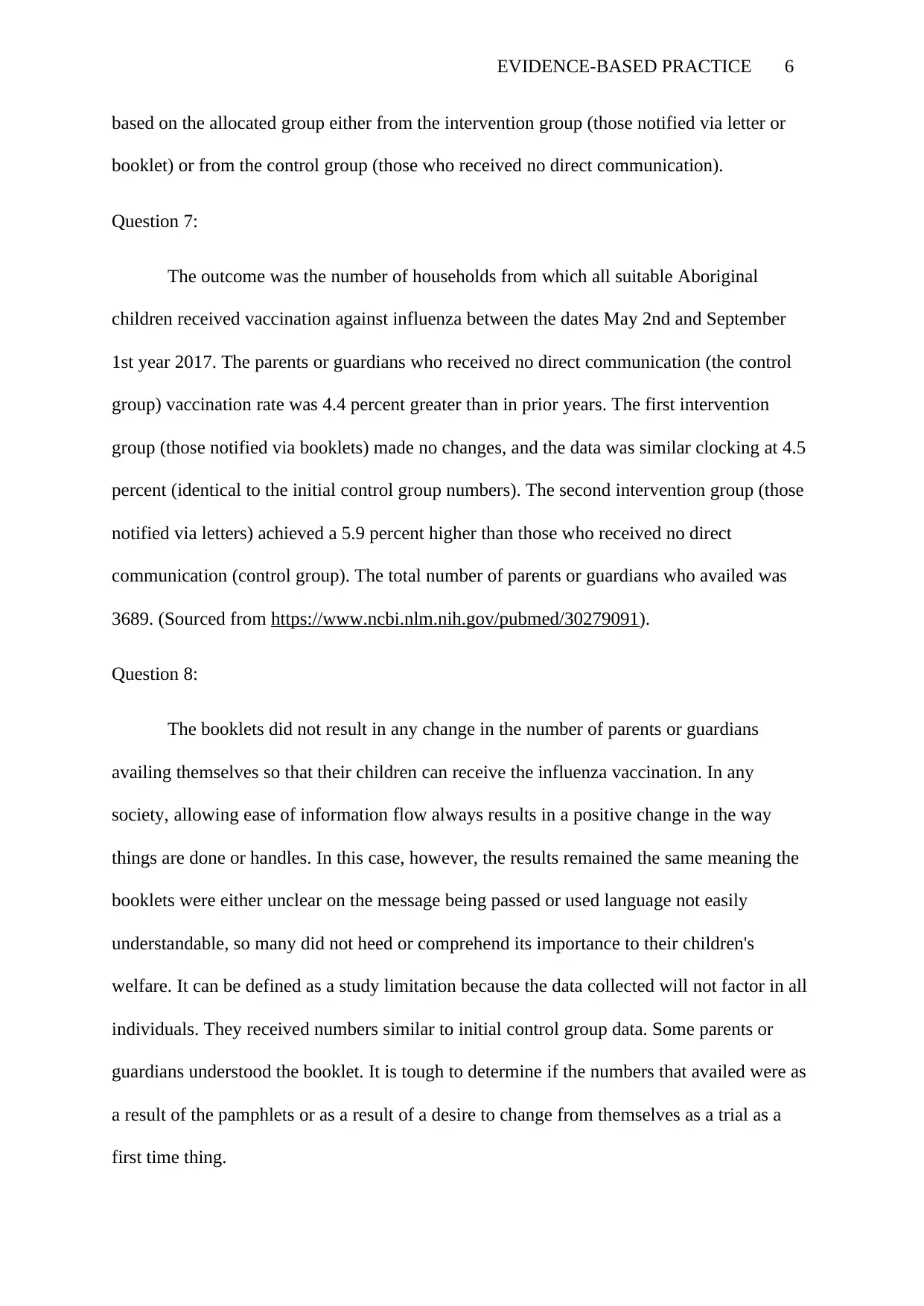
EVIDENCE-BASED PRACTICE 6
based on the allocated group either from the intervention group (those notified via letter or
booklet) or from the control group (those who received no direct communication).
Question 7:
The outcome was the number of households from which all suitable Aboriginal
children received vaccination against influenza between the dates May 2nd and September
1st year 2017. The parents or guardians who received no direct communication (the control
group) vaccination rate was 4.4 percent greater than in prior years. The first intervention
group (those notified via booklets) made no changes, and the data was similar clocking at 4.5
percent (identical to the initial control group numbers). The second intervention group (those
notified via letters) achieved a 5.9 percent higher than those who received no direct
communication (control group). The total number of parents or guardians who availed was
3689. (Sourced from https://www.ncbi.nlm.nih.gov/pubmed/30279091).
Question 8:
The booklets did not result in any change in the number of parents or guardians
availing themselves so that their children can receive the influenza vaccination. In any
society, allowing ease of information flow always results in a positive change in the way
things are done or handles. In this case, however, the results remained the same meaning the
booklets were either unclear on the message being passed or used language not easily
understandable, so many did not heed or comprehend its importance to their children's
welfare. It can be defined as a study limitation because the data collected will not factor in all
individuals. They received numbers similar to initial control group data. Some parents or
guardians understood the booklet. It is tough to determine if the numbers that availed were as
a result of the pamphlets or as a result of a desire to change from themselves as a trial as a
first time thing.
based on the allocated group either from the intervention group (those notified via letter or
booklet) or from the control group (those who received no direct communication).
Question 7:
The outcome was the number of households from which all suitable Aboriginal
children received vaccination against influenza between the dates May 2nd and September
1st year 2017. The parents or guardians who received no direct communication (the control
group) vaccination rate was 4.4 percent greater than in prior years. The first intervention
group (those notified via booklets) made no changes, and the data was similar clocking at 4.5
percent (identical to the initial control group numbers). The second intervention group (those
notified via letters) achieved a 5.9 percent higher than those who received no direct
communication (control group). The total number of parents or guardians who availed was
3689. (Sourced from https://www.ncbi.nlm.nih.gov/pubmed/30279091).
Question 8:
The booklets did not result in any change in the number of parents or guardians
availing themselves so that their children can receive the influenza vaccination. In any
society, allowing ease of information flow always results in a positive change in the way
things are done or handles. In this case, however, the results remained the same meaning the
booklets were either unclear on the message being passed or used language not easily
understandable, so many did not heed or comprehend its importance to their children's
welfare. It can be defined as a study limitation because the data collected will not factor in all
individuals. They received numbers similar to initial control group data. Some parents or
guardians understood the booklet. It is tough to determine if the numbers that availed were as
a result of the pamphlets or as a result of a desire to change from themselves as a trial as a
first time thing.
⊘ This is a preview!⊘
Do you want full access?
Subscribe today to unlock all pages.

Trusted by 1+ million students worldwide

EVIDENCE-BASED PRACTICE 7
If the study is biased, then the collected data will not be in adherence to the control
and intervention measures resulting in corruption. Corrupting the statistical data will have
diminished the validity of the study because it will be uncertain which measures adhered to
the set measures. Additionally, each group depends on the other to offer a full analysis of the
statistical data (Emsley, 2010, pp. 242).
Question 9:
According to the Levels of Evidence pyramid, what level of evidence is the reported results
from this paper?
The results can be regarded to fit in level one.
Overall, should the outcomes of this study be used to inform evidence-based practice?
Yes.
The results fit in level one because the study was a well-designed multiarm parallel
randomized control trial. The booklets might not have presented the results as expected due
to some factors mentioned earlier, but all others adhere to the measures of a well-designed
randomized control trial (Fineout-Overholt, 2005, pp. 339). The results can be used to inform
evidence-based practices for the fact that the results acquired from the study achieved a better
vaccination success rate from the previous influenza vaccination results recorded.
Reflection
I had a basic comprehension of immunization safety for children before undertaking
the assessment. Immunization is quite significant in saving a child's life, preventing diseases
and illnesses that initially would have been avoided, protecting future generations, saving
financial resources among many others. Immunization helps in protecting the child from
avoidable diseases. Immunization safety is, however, the key to achieving all the objectives
If the study is biased, then the collected data will not be in adherence to the control
and intervention measures resulting in corruption. Corrupting the statistical data will have
diminished the validity of the study because it will be uncertain which measures adhered to
the set measures. Additionally, each group depends on the other to offer a full analysis of the
statistical data (Emsley, 2010, pp. 242).
Question 9:
According to the Levels of Evidence pyramid, what level of evidence is the reported results
from this paper?
The results can be regarded to fit in level one.
Overall, should the outcomes of this study be used to inform evidence-based practice?
Yes.
The results fit in level one because the study was a well-designed multiarm parallel
randomized control trial. The booklets might not have presented the results as expected due
to some factors mentioned earlier, but all others adhere to the measures of a well-designed
randomized control trial (Fineout-Overholt, 2005, pp. 339). The results can be used to inform
evidence-based practices for the fact that the results acquired from the study achieved a better
vaccination success rate from the previous influenza vaccination results recorded.
Reflection
I had a basic comprehension of immunization safety for children before undertaking
the assessment. Immunization is quite significant in saving a child's life, preventing diseases
and illnesses that initially would have been avoided, protecting future generations, saving
financial resources among many others. Immunization helps in protecting the child from
avoidable diseases. Immunization safety is, however, the key to achieving all the objectives
Paraphrase This Document
Need a fresh take? Get an instant paraphrase of this document with our AI Paraphraser
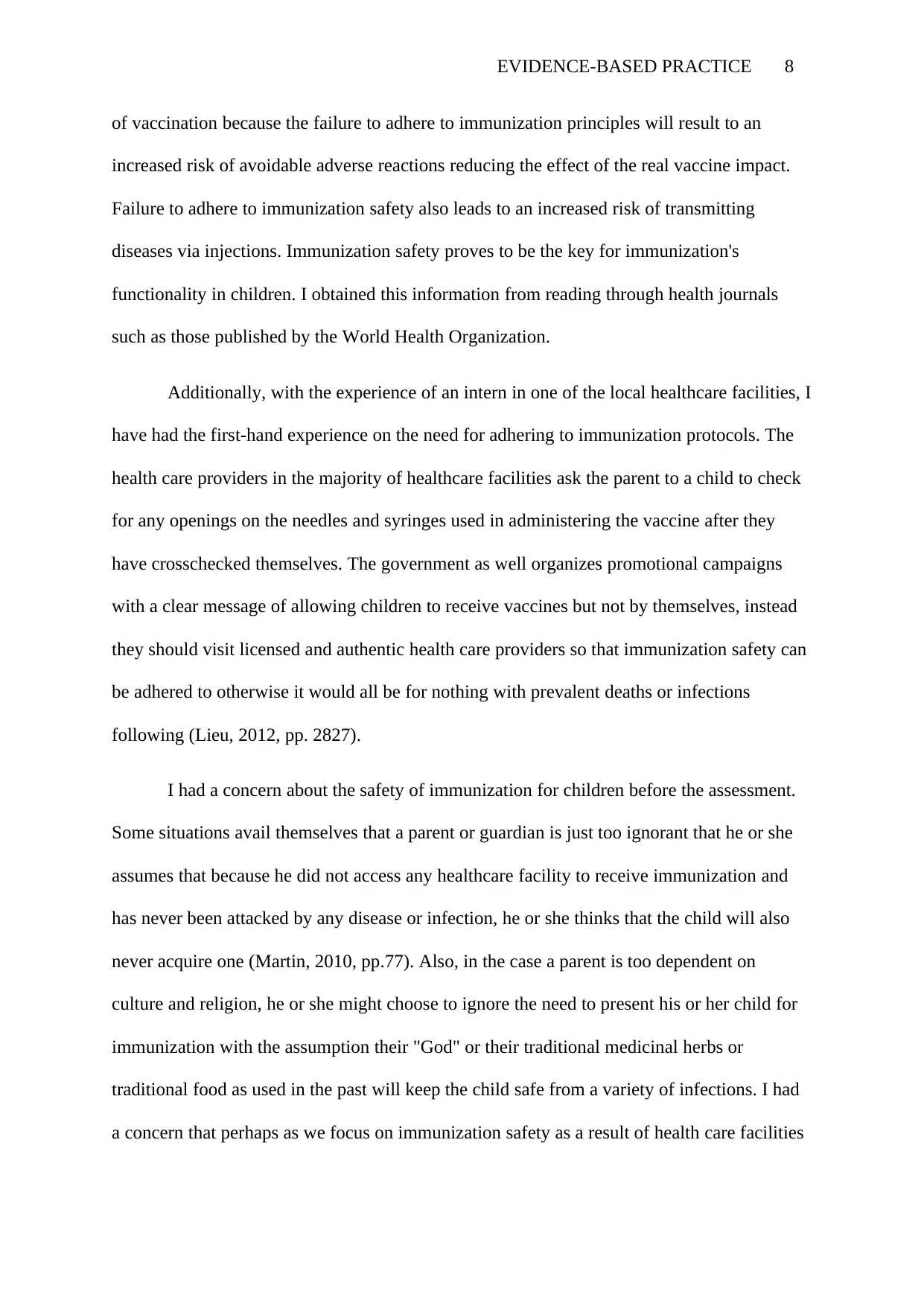
EVIDENCE-BASED PRACTICE 8
of vaccination because the failure to adhere to immunization principles will result to an
increased risk of avoidable adverse reactions reducing the effect of the real vaccine impact.
Failure to adhere to immunization safety also leads to an increased risk of transmitting
diseases via injections. Immunization safety proves to be the key for immunization's
functionality in children. I obtained this information from reading through health journals
such as those published by the World Health Organization.
Additionally, with the experience of an intern in one of the local healthcare facilities, I
have had the first-hand experience on the need for adhering to immunization protocols. The
health care providers in the majority of healthcare facilities ask the parent to a child to check
for any openings on the needles and syringes used in administering the vaccine after they
have crosschecked themselves. The government as well organizes promotional campaigns
with a clear message of allowing children to receive vaccines but not by themselves, instead
they should visit licensed and authentic health care providers so that immunization safety can
be adhered to otherwise it would all be for nothing with prevalent deaths or infections
following (Lieu, 2012, pp. 2827).
I had a concern about the safety of immunization for children before the assessment.
Some situations avail themselves that a parent or guardian is just too ignorant that he or she
assumes that because he did not access any healthcare facility to receive immunization and
has never been attacked by any disease or infection, he or she thinks that the child will also
never acquire one (Martin, 2010, pp.77). Also, in the case a parent is too dependent on
culture and religion, he or she might choose to ignore the need to present his or her child for
immunization with the assumption their "God" or their traditional medicinal herbs or
traditional food as used in the past will keep the child safe from a variety of infections. I had
a concern that perhaps as we focus on immunization safety as a result of health care facilities
of vaccination because the failure to adhere to immunization principles will result to an
increased risk of avoidable adverse reactions reducing the effect of the real vaccine impact.
Failure to adhere to immunization safety also leads to an increased risk of transmitting
diseases via injections. Immunization safety proves to be the key for immunization's
functionality in children. I obtained this information from reading through health journals
such as those published by the World Health Organization.
Additionally, with the experience of an intern in one of the local healthcare facilities, I
have had the first-hand experience on the need for adhering to immunization protocols. The
health care providers in the majority of healthcare facilities ask the parent to a child to check
for any openings on the needles and syringes used in administering the vaccine after they
have crosschecked themselves. The government as well organizes promotional campaigns
with a clear message of allowing children to receive vaccines but not by themselves, instead
they should visit licensed and authentic health care providers so that immunization safety can
be adhered to otherwise it would all be for nothing with prevalent deaths or infections
following (Lieu, 2012, pp. 2827).
I had a concern about the safety of immunization for children before the assessment.
Some situations avail themselves that a parent or guardian is just too ignorant that he or she
assumes that because he did not access any healthcare facility to receive immunization and
has never been attacked by any disease or infection, he or she thinks that the child will also
never acquire one (Martin, 2010, pp.77). Also, in the case a parent is too dependent on
culture and religion, he or she might choose to ignore the need to present his or her child for
immunization with the assumption their "God" or their traditional medicinal herbs or
traditional food as used in the past will keep the child safe from a variety of infections. I had
a concern that perhaps as we focus on immunization safety as a result of health care facilities
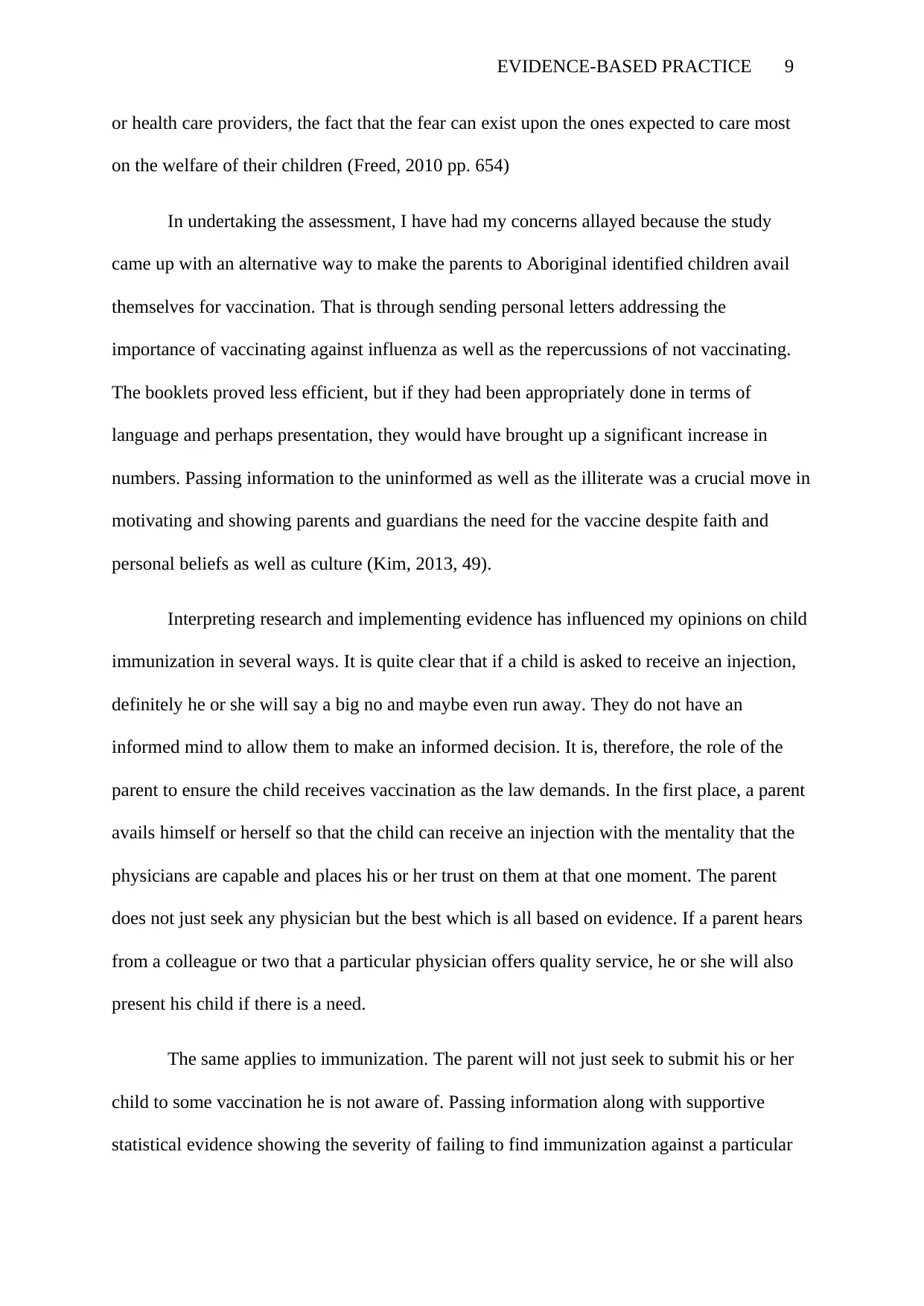
EVIDENCE-BASED PRACTICE 9
or health care providers, the fact that the fear can exist upon the ones expected to care most
on the welfare of their children (Freed, 2010 pp. 654)
In undertaking the assessment, I have had my concerns allayed because the study
came up with an alternative way to make the parents to Aboriginal identified children avail
themselves for vaccination. That is through sending personal letters addressing the
importance of vaccinating against influenza as well as the repercussions of not vaccinating.
The booklets proved less efficient, but if they had been appropriately done in terms of
language and perhaps presentation, they would have brought up a significant increase in
numbers. Passing information to the uninformed as well as the illiterate was a crucial move in
motivating and showing parents and guardians the need for the vaccine despite faith and
personal beliefs as well as culture (Kim, 2013, 49).
Interpreting research and implementing evidence has influenced my opinions on child
immunization in several ways. It is quite clear that if a child is asked to receive an injection,
definitely he or she will say a big no and maybe even run away. They do not have an
informed mind to allow them to make an informed decision. It is, therefore, the role of the
parent to ensure the child receives vaccination as the law demands. In the first place, a parent
avails himself or herself so that the child can receive an injection with the mentality that the
physicians are capable and places his or her trust on them at that one moment. The parent
does not just seek any physician but the best which is all based on evidence. If a parent hears
from a colleague or two that a particular physician offers quality service, he or she will also
present his child if there is a need.
The same applies to immunization. The parent will not just seek to submit his or her
child to some vaccination he is not aware of. Passing information along with supportive
statistical evidence showing the severity of failing to find immunization against a particular
or health care providers, the fact that the fear can exist upon the ones expected to care most
on the welfare of their children (Freed, 2010 pp. 654)
In undertaking the assessment, I have had my concerns allayed because the study
came up with an alternative way to make the parents to Aboriginal identified children avail
themselves for vaccination. That is through sending personal letters addressing the
importance of vaccinating against influenza as well as the repercussions of not vaccinating.
The booklets proved less efficient, but if they had been appropriately done in terms of
language and perhaps presentation, they would have brought up a significant increase in
numbers. Passing information to the uninformed as well as the illiterate was a crucial move in
motivating and showing parents and guardians the need for the vaccine despite faith and
personal beliefs as well as culture (Kim, 2013, 49).
Interpreting research and implementing evidence has influenced my opinions on child
immunization in several ways. It is quite clear that if a child is asked to receive an injection,
definitely he or she will say a big no and maybe even run away. They do not have an
informed mind to allow them to make an informed decision. It is, therefore, the role of the
parent to ensure the child receives vaccination as the law demands. In the first place, a parent
avails himself or herself so that the child can receive an injection with the mentality that the
physicians are capable and places his or her trust on them at that one moment. The parent
does not just seek any physician but the best which is all based on evidence. If a parent hears
from a colleague or two that a particular physician offers quality service, he or she will also
present his child if there is a need.
The same applies to immunization. The parent will not just seek to submit his or her
child to some vaccination he is not aware of. Passing information along with supportive
statistical evidence showing the severity of failing to find immunization against a particular
⊘ This is a preview!⊘
Do you want full access?
Subscribe today to unlock all pages.

Trusted by 1+ million students worldwide
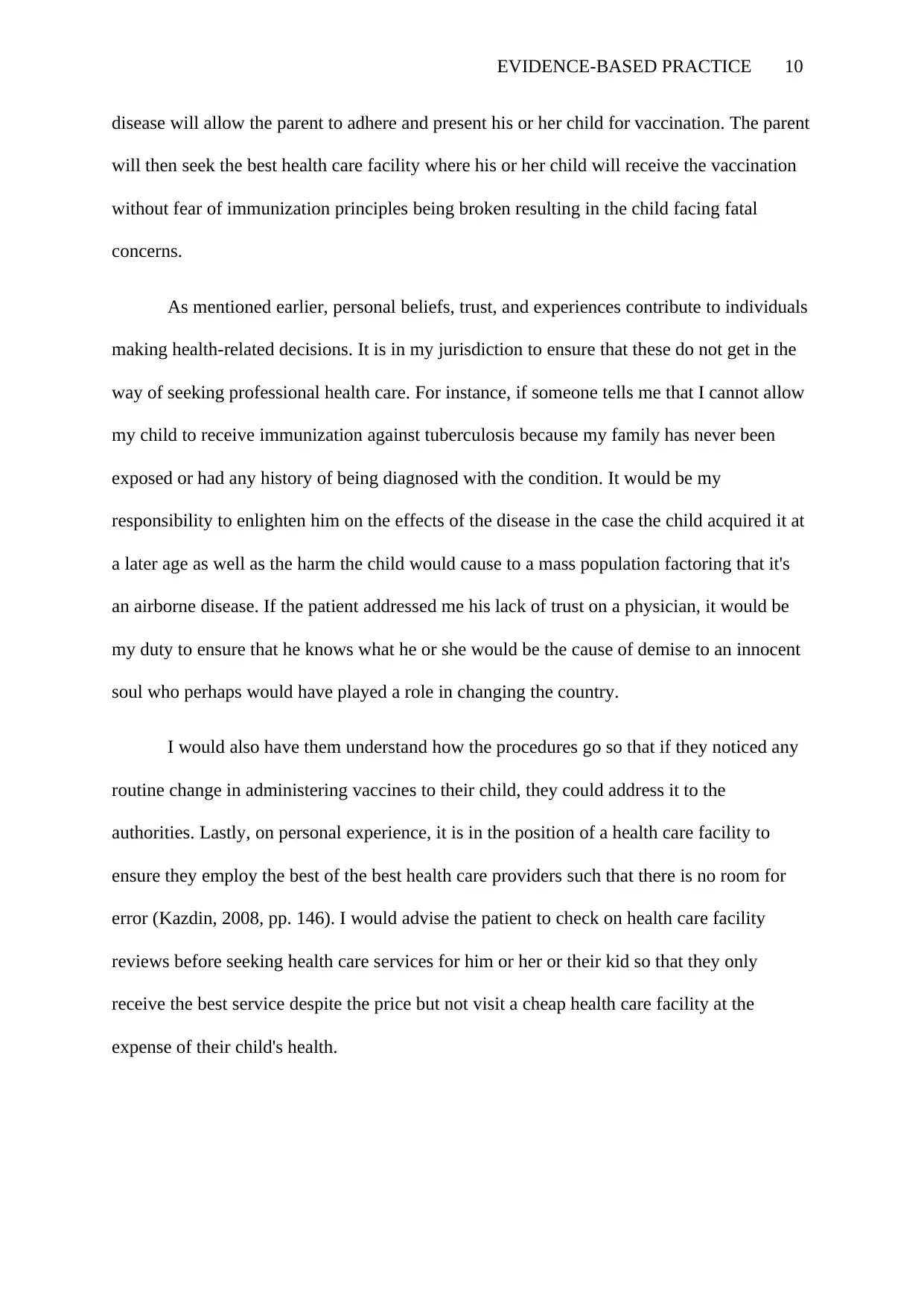
EVIDENCE-BASED PRACTICE 10
disease will allow the parent to adhere and present his or her child for vaccination. The parent
will then seek the best health care facility where his or her child will receive the vaccination
without fear of immunization principles being broken resulting in the child facing fatal
concerns.
As mentioned earlier, personal beliefs, trust, and experiences contribute to individuals
making health-related decisions. It is in my jurisdiction to ensure that these do not get in the
way of seeking professional health care. For instance, if someone tells me that I cannot allow
my child to receive immunization against tuberculosis because my family has never been
exposed or had any history of being diagnosed with the condition. It would be my
responsibility to enlighten him on the effects of the disease in the case the child acquired it at
a later age as well as the harm the child would cause to a mass population factoring that it's
an airborne disease. If the patient addressed me his lack of trust on a physician, it would be
my duty to ensure that he knows what he or she would be the cause of demise to an innocent
soul who perhaps would have played a role in changing the country.
I would also have them understand how the procedures go so that if they noticed any
routine change in administering vaccines to their child, they could address it to the
authorities. Lastly, on personal experience, it is in the position of a health care facility to
ensure they employ the best of the best health care providers such that there is no room for
error (Kazdin, 2008, pp. 146). I would advise the patient to check on health care facility
reviews before seeking health care services for him or her or their kid so that they only
receive the best service despite the price but not visit a cheap health care facility at the
expense of their child's health.
disease will allow the parent to adhere and present his or her child for vaccination. The parent
will then seek the best health care facility where his or her child will receive the vaccination
without fear of immunization principles being broken resulting in the child facing fatal
concerns.
As mentioned earlier, personal beliefs, trust, and experiences contribute to individuals
making health-related decisions. It is in my jurisdiction to ensure that these do not get in the
way of seeking professional health care. For instance, if someone tells me that I cannot allow
my child to receive immunization against tuberculosis because my family has never been
exposed or had any history of being diagnosed with the condition. It would be my
responsibility to enlighten him on the effects of the disease in the case the child acquired it at
a later age as well as the harm the child would cause to a mass population factoring that it's
an airborne disease. If the patient addressed me his lack of trust on a physician, it would be
my duty to ensure that he knows what he or she would be the cause of demise to an innocent
soul who perhaps would have played a role in changing the country.
I would also have them understand how the procedures go so that if they noticed any
routine change in administering vaccines to their child, they could address it to the
authorities. Lastly, on personal experience, it is in the position of a health care facility to
ensure they employ the best of the best health care providers such that there is no room for
error (Kazdin, 2008, pp. 146). I would advise the patient to check on health care facility
reviews before seeking health care services for him or her or their kid so that they only
receive the best service despite the price but not visit a cheap health care facility at the
expense of their child's health.
Paraphrase This Document
Need a fresh take? Get an instant paraphrase of this document with our AI Paraphraser
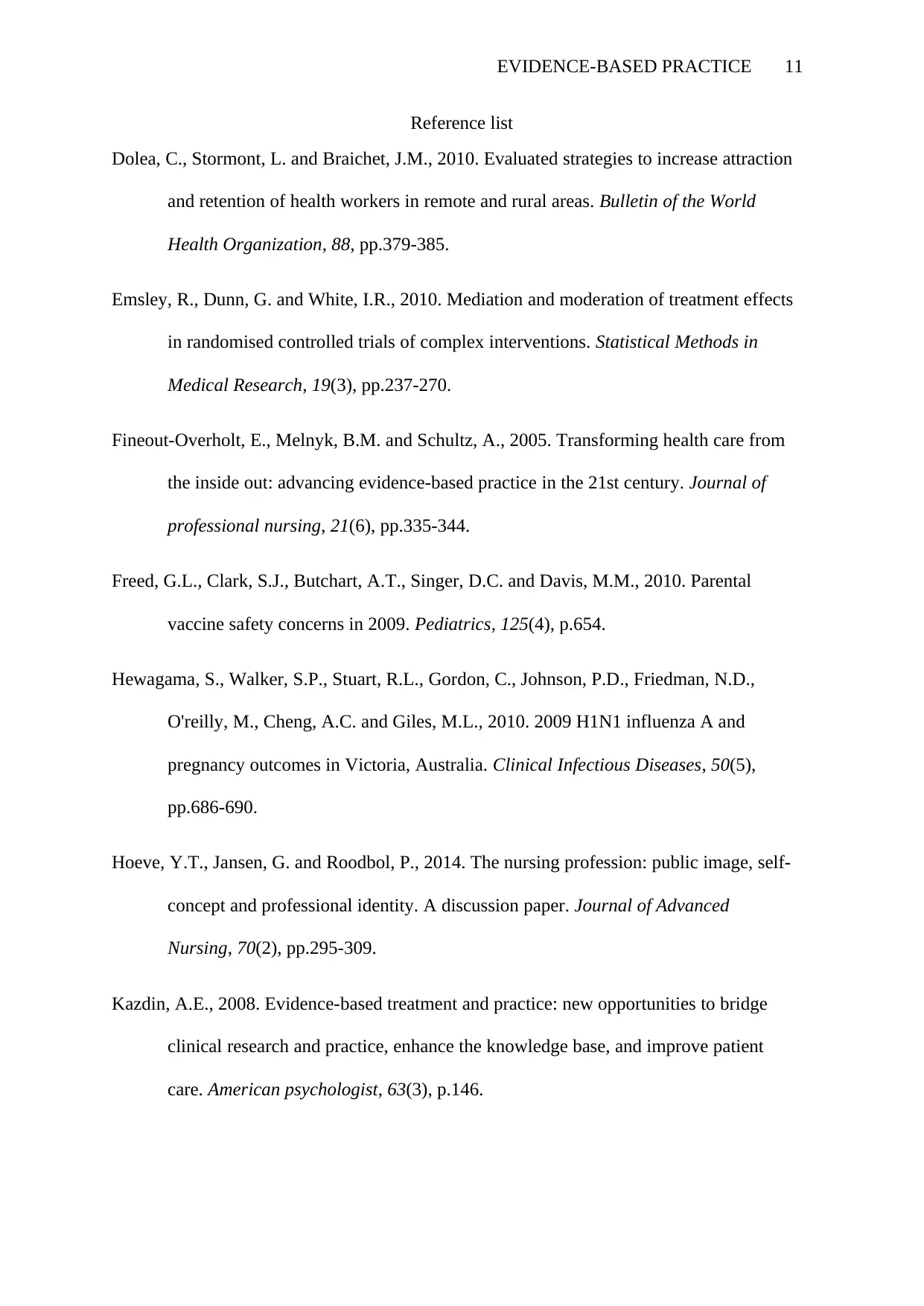
EVIDENCE-BASED PRACTICE 11
Reference list
Dolea, C., Stormont, L. and Braichet, J.M., 2010. Evaluated strategies to increase attraction
and retention of health workers in remote and rural areas. Bulletin of the World
Health Organization, 88, pp.379-385.
Emsley, R., Dunn, G. and White, I.R., 2010. Mediation and moderation of treatment effects
in randomised controlled trials of complex interventions. Statistical Methods in
Medical Research, 19(3), pp.237-270.
Fineout-Overholt, E., Melnyk, B.M. and Schultz, A., 2005. Transforming health care from
the inside out: advancing evidence-based practice in the 21st century. Journal of
professional nursing, 21(6), pp.335-344.
Freed, G.L., Clark, S.J., Butchart, A.T., Singer, D.C. and Davis, M.M., 2010. Parental
vaccine safety concerns in 2009. Pediatrics, 125(4), p.654.
Hewagama, S., Walker, S.P., Stuart, R.L., Gordon, C., Johnson, P.D., Friedman, N.D.,
O'reilly, M., Cheng, A.C. and Giles, M.L., 2010. 2009 H1N1 influenza A and
pregnancy outcomes in Victoria, Australia. Clinical Infectious Diseases, 50(5),
pp.686-690.
Hoeve, Y.T., Jansen, G. and Roodbol, P., 2014. The nursing profession: public image, self‐
concept and professional identity. A discussion paper. Journal of Advanced
Nursing, 70(2), pp.295-309.
Kazdin, A.E., 2008. Evidence-based treatment and practice: new opportunities to bridge
clinical research and practice, enhance the knowledge base, and improve patient
care. American psychologist, 63(3), p.146.
Reference list
Dolea, C., Stormont, L. and Braichet, J.M., 2010. Evaluated strategies to increase attraction
and retention of health workers in remote and rural areas. Bulletin of the World
Health Organization, 88, pp.379-385.
Emsley, R., Dunn, G. and White, I.R., 2010. Mediation and moderation of treatment effects
in randomised controlled trials of complex interventions. Statistical Methods in
Medical Research, 19(3), pp.237-270.
Fineout-Overholt, E., Melnyk, B.M. and Schultz, A., 2005. Transforming health care from
the inside out: advancing evidence-based practice in the 21st century. Journal of
professional nursing, 21(6), pp.335-344.
Freed, G.L., Clark, S.J., Butchart, A.T., Singer, D.C. and Davis, M.M., 2010. Parental
vaccine safety concerns in 2009. Pediatrics, 125(4), p.654.
Hewagama, S., Walker, S.P., Stuart, R.L., Gordon, C., Johnson, P.D., Friedman, N.D.,
O'reilly, M., Cheng, A.C. and Giles, M.L., 2010. 2009 H1N1 influenza A and
pregnancy outcomes in Victoria, Australia. Clinical Infectious Diseases, 50(5),
pp.686-690.
Hoeve, Y.T., Jansen, G. and Roodbol, P., 2014. The nursing profession: public image, self‐
concept and professional identity. A discussion paper. Journal of Advanced
Nursing, 70(2), pp.295-309.
Kazdin, A.E., 2008. Evidence-based treatment and practice: new opportunities to bridge
clinical research and practice, enhance the knowledge base, and improve patient
care. American psychologist, 63(3), p.146.
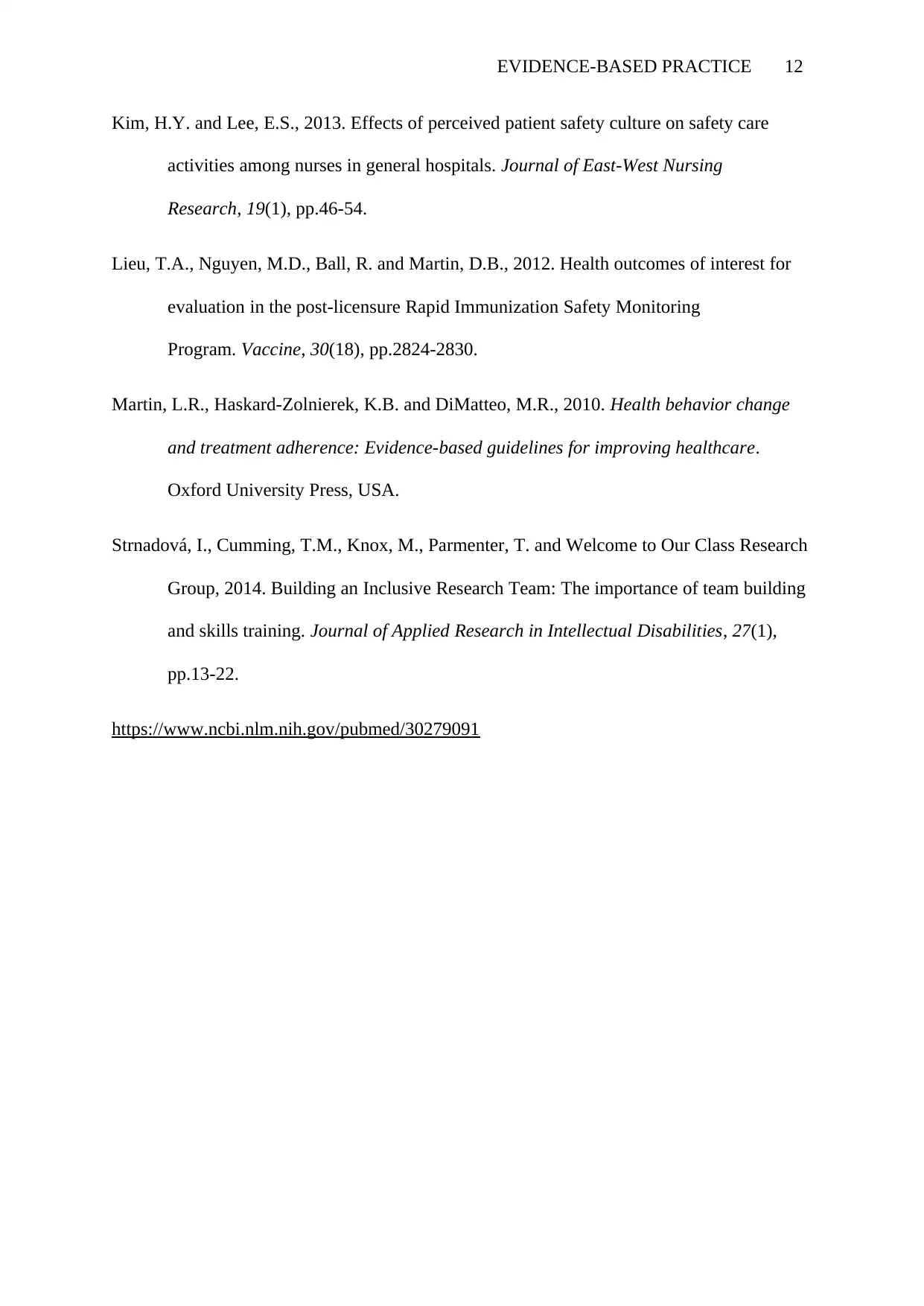
EVIDENCE-BASED PRACTICE 12
Kim, H.Y. and Lee, E.S., 2013. Effects of perceived patient safety culture on safety care
activities among nurses in general hospitals. Journal of East-West Nursing
Research, 19(1), pp.46-54.
Lieu, T.A., Nguyen, M.D., Ball, R. and Martin, D.B., 2012. Health outcomes of interest for
evaluation in the post-licensure Rapid Immunization Safety Monitoring
Program. Vaccine, 30(18), pp.2824-2830.
Martin, L.R., Haskard-Zolnierek, K.B. and DiMatteo, M.R., 2010. Health behavior change
and treatment adherence: Evidence-based guidelines for improving healthcare.
Oxford University Press, USA.
Strnadová, I., Cumming, T.M., Knox, M., Parmenter, T. and Welcome to Our Class Research
Group, 2014. Building an Inclusive Research Team: The importance of team building
and skills training. Journal of Applied Research in Intellectual Disabilities, 27(1),
pp.13-22.
https://www.ncbi.nlm.nih.gov/pubmed/30279091
Kim, H.Y. and Lee, E.S., 2013. Effects of perceived patient safety culture on safety care
activities among nurses in general hospitals. Journal of East-West Nursing
Research, 19(1), pp.46-54.
Lieu, T.A., Nguyen, M.D., Ball, R. and Martin, D.B., 2012. Health outcomes of interest for
evaluation in the post-licensure Rapid Immunization Safety Monitoring
Program. Vaccine, 30(18), pp.2824-2830.
Martin, L.R., Haskard-Zolnierek, K.B. and DiMatteo, M.R., 2010. Health behavior change
and treatment adherence: Evidence-based guidelines for improving healthcare.
Oxford University Press, USA.
Strnadová, I., Cumming, T.M., Knox, M., Parmenter, T. and Welcome to Our Class Research
Group, 2014. Building an Inclusive Research Team: The importance of team building
and skills training. Journal of Applied Research in Intellectual Disabilities, 27(1),
pp.13-22.
https://www.ncbi.nlm.nih.gov/pubmed/30279091
⊘ This is a preview!⊘
Do you want full access?
Subscribe today to unlock all pages.

Trusted by 1+ million students worldwide
1 out of 12
Related Documents
Your All-in-One AI-Powered Toolkit for Academic Success.
+13062052269
info@desklib.com
Available 24*7 on WhatsApp / Email
![[object Object]](/_next/static/media/star-bottom.7253800d.svg)
Unlock your academic potential
© 2024 | Zucol Services PVT LTD | All rights reserved.





